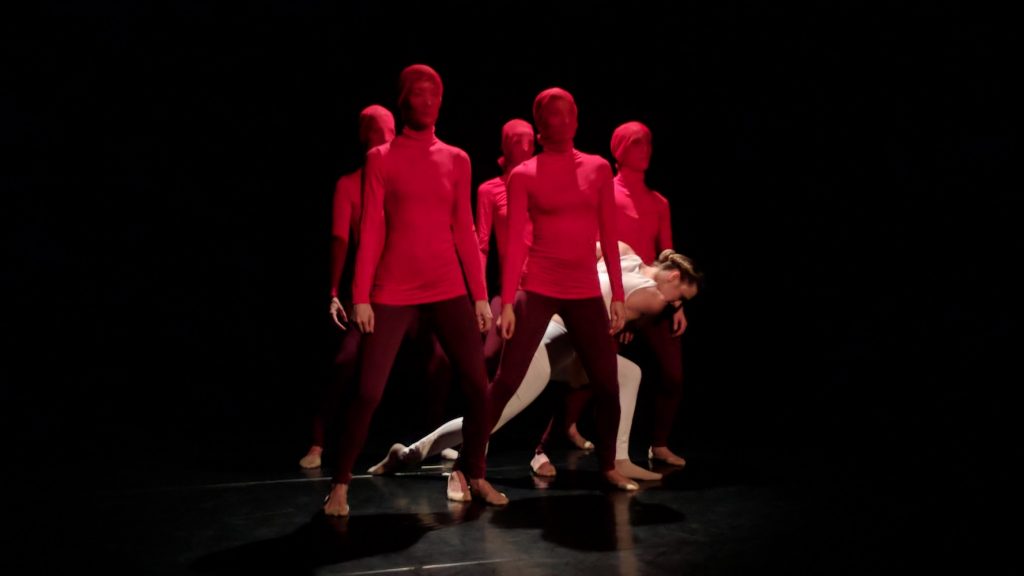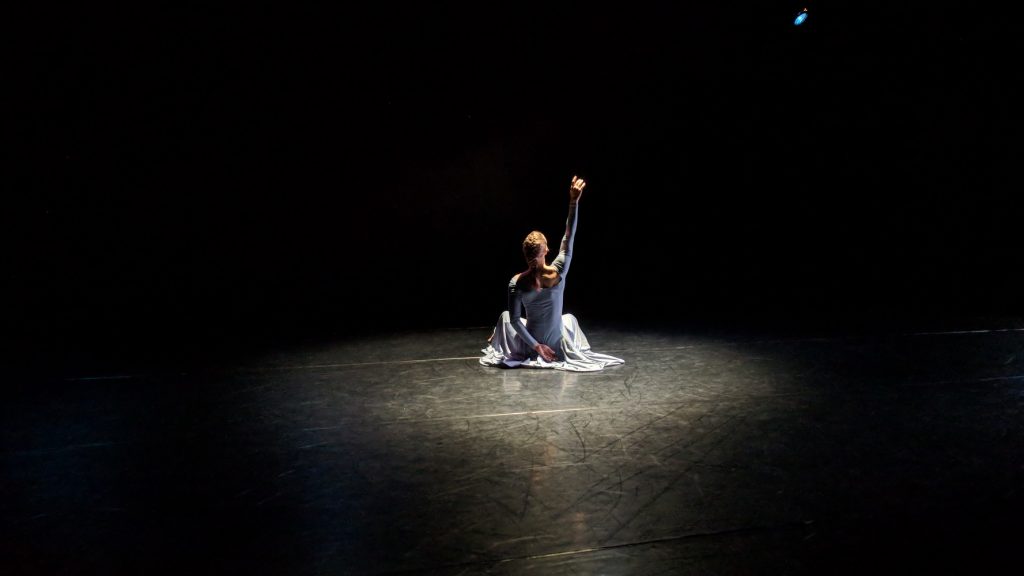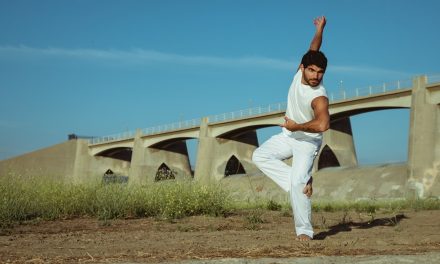There is a beautiful artistic flower in full bloom in Pasadena by the name of Nancy Evans Doede, the Artistic Director of Nancy Evans Dance Theatre (NEDT). Evans established her company in 2009 and her work has continued to grow. For the company’s recent performance at the ARC in Pasadena, Evans dug even deeper into both herself and her artistic past. The concert was entitled From The Source, The Legacy of Mary Wigman and featured the reconstruction of an extraordinary work choreographed in 1978 by Nancy Hauser titled EVERNESS. The person who reconstructed Everness was Hauser’s daughter Heidi Hauser Jasmin. Nancy Hauser performed with the Hanya Holm Dance Company (1932-1936). Holm was sent to America from Germany in 1931 to open a dance school by German Expressionist dancer and choreographer, Mary Wigman, one of the earliest pioneers of Modern Dance. In 1936 that studio became the Mary Wigman School in New York City. This is the dance lineage that traces from Wigman to Evans.
The legacy continued as Evan’s daughter Ashleigh Doede both performed with the company and premiered a work of her own. Nikolaos Doede, Evan’s son, lives and works in Germany and in 2013 choreographed a new work for NEDT. Other works on the program were created by founding company members Jenn Logan and Katrina Amerine.
One of the things I found so beautiful about this performance was its conveyance of pure modern dance. The choreographers did not fuse their dance styles with others; nor did they try to impress the audience with multiple technical feats. The dancers are excellent and capable of such dance maneuvers, but these dance artists chose to let their vision speak for itself. And speak they did!

Nancy Evans Dance Theatre in “Tick” by Jenn Logan – Photo: Roger Martin Holman for LA Dance Chronicle
Ashleigh Doede choreographed TICK to the music of Nils Frahm’s All Melody. The music is extremely rhythmical, with a very prominent and constant beat. Underneath this driving sound, almost hidden at times, is a lovely soft, romantic melody. Doede choregraphed to both and wove them together in a very sophisticated manner. It opens with three women sitting with their backs facing the audience. Subtle and rhythmic hand and arm movements set up the visual beat before they stand to dance. The performers shift from duets dancing totally to the tick tick of the music, to gorgeous lyrical movements. The three very talented dancers were Katrina Amerine, Noel Dilworth and Jenn Logan. The beautiful costumes that flowed with the movement and exposed the strong back work of the dancers were by Amerine.

Nancy Evans Dance Theatre – Jenn Logan in her “Iladefonsa Impala” – Photo: Roger Martin Holman for LA Dance Chronicle
Jenn Logan is a strong, talented and commanding performer. She choreographed and performed in her new work titled FROM THE LIPS OF ILDEFONSA IMPALA, a character from a story by R. A Lafferty, Slow Tuesday Night. Ildefonsa is a beautiful woman who enjoys being with many men. Dressed in a white dress over an underskirt made of black, blown up rubber gloves, Logan performed a portrait of this flirtatious woman. She flirted, mimed imbibing a few drinks and used her black rubber glove choker as a comb and fan during a tipsy rendition of a Spanish dance. The music was by Jun Miyake and Logan designed the very inventive, and humorous costume.

Nancy Evans Dance Theatre in Nikolaos Doede’s “There Between” – Photo: Roger Martin Holman for LA Dance Chronicle
As a semi-finalist in 2008 Prix de Lausanne, Nikolas Doede went to Hamburg Ballet school for three years, danced for four years at Ballett Kiel, 2 years at Ballett Hagen, and has just completed his first season with Ballett Augsburg. This is a testament to his early training with his mother Nancy Evans Doede. THERE BETWEEN is a haunting work, set to music by Max Richter. Three women, who could be sisters, are trapped in a triangle of devotion and the desire of one to have a life of her own. On the other side of things, this could be a dance of memory; one of the trio of women remembering her past.
One woman (Ashleigh Doede) sits with her back to the audience for at least half of the dance. The other two (Amerine and Logan) perform a duet laced with lovely partnering. It portraits one woman leaving and the sadness of that parting. Amerine dances the role of the one left behind to care for the third; a woman who appears totally dependent on her.
WHICH WAY IS UP? Is a very humorous solo choreographed and performed by Katrina Amerine, who spends all but the last 30 seconds of this work in a handstand with her white lacy petticoat covering up her torso and head. This is a solo of two legs. They walk upstairs, twist around each other, perform the splits and dance. My only complaint is that Amerine peeks out from underneath her petticoats at the end. I was hoping that she would not because her character’s legs working as if she were upright in itself gave us the full meaning to her title. The music was by Mexican composer Juan Garcia Esquivel.

Nancy Evans Dance Theatre in “Yield” by Jenn Logan – Photo: Roger Martin Holman for LA Dance Chronicle
YIELD was choreographed by Jenn Logan to the music of Mark Applebaum and Joe Hisaishi, and the subject of this well-made work spoke to our current political climate, and this administration’s attempts at the subjugation of women. Five women dressed in all red, with their heads and faces covered with a red gauze; stripping them of their individuality. A sixth woman was dressed similarly but in all white and surrounded by the others. The work depicts a woman’s struggle for independence and to find freedom. She almost convinces the others to join her, but sadly yields to her oppressors. The talented cast of YIELD were: Karina Amerine, Noel Dilworth, Ashleigh Doede, Jen Hunter, Karina Jones, and Jenn Logan.
Nancy Evans Doede said in an interview, “…..The fact that my teacher had studied with Wigman at the end of the pioneer’s life didn’t mean much to me until I saw a dance choreographed by her protégé, Hanya Holm. That led me to study with Hanya, who told me many stories about the early days with Wigman in Dresden, Germany. Hanya led me to Nancy Hauser, who gave me incredible opportunities to dance, choreograph and teach, all based in the principles that go back to Wigman.”

Nancy Evans Dance Theatre – Nancy Evans performing her Zwei Seelen Wohnen Ach In Meiner Brust – photo: Roger Martin Holman for LA Dance Chronicle
In her solo ZWEI SEELEN WOHNEN ACH IN MEINER BRUST (“Two souls alas! Are dwelling in my breast” J.W. von Goethe) Evans lovingly portrays her mentor Hanya Holm. Holm was 86 when Evans studied with her one summer at Colorado Springs. Evans takes on her persona and relates how Holm spoke to her in class and how she moved her head due to the loss of her peripheral vision. Stating that she wishes that she could turn back time to see Holm perform, Evans reverses her movement, removes a visor and begins to dance.
Evans never saw Hanya Holm dance and there are only photographs of her doing so. The solo was not an attempt to dance like Holm, but for Evans to allow the spirit of this amazing woman and dance pioneer to speak through her body. She embodied the lineage of Wigman, Holm and Hauser to flow through her and the result was breathtaking.
I first met Heidi Hauser Jasmin and her mother, Nancy, in Minneapolis during the early 1970s when my ex-wife, dance partner and mentor, Viola Farber was there creating a new work on Hauser’s company. This was, however, my first time experiencing the beauty of Hauser’s 1978 work titled EVERNESS. The title is perfect, as Everness felt eternal; without beginning or end.

Nancy Evans Dance Theatre – “Everness” by Nancy Hauser – Photo: Roger Martin Holman for LA Dance Chronicle
Hauser Jasmin was at this performance and stated afterwards that it was difficult for her to release this work because it included the only solo that her mother choreographed for her. She did a stellar job of reconstructing EVERNESS and the world is grateful that she did so, as this work needs to be seen by as many dancers and choreographers as possible. The movements are simple and eloquent. The structure is simplistic but extraordinarily complex. If there is an afterlife, I am certain that her mother, Nancy Hauser, was smiling down approvingly.
Until now, EVERNESS was only performed by the Nancy Hauser Dance Company. “It was done to pay homage to Mary Wigman, to whom I owe a great deal, “ noted Nancy Hauser. “The concept has to do with space, curves, with turning, with moments of quiet and moments of tremendous momentum.”

Nancy Evans Dance Theatre in “Everness” by Nancy Hauser – Photo: Roger Martin Holman for LA Dance Chronicle
The dancers spun in place a la whirling dervishes, ran unrushed in circles, paused briefly to connect and revolve around each other in surprising ways, only to continue through time and space; never to age or end. The dance took on what felt like the essence of Hauser’s vision. It was not cluttered with any unnecessary movements or elements, but it had a powerful and emotional impact on the viewer. Everness means perpetuity and Nancy Hauser exquisitely captured that meaning.
Choreographed by Evans, DAUGHTERS OF THE EARTH was inspired by the movement qualities used by Wigman. The work, which had its premiere on this concert, was divided into seven sections; each with its own music. The work needs time to mature and gel together, but despite a few timing issues with dancers, DAUGHTERS OF THE EARTH was a wonderful tribute to one of the mothers of modern dance. Each principle that Evans explored was listed in the program.

Nancy Evans Dance Theatre in Evans’ “Daughter of the Earth” – Photo: Roger Martin Holman for LA Dance Chronicle
Emergence, music by Norwegian composer Terje Isungset and performed by the company, was led by Evans. Dressed all in black, the section took on a feel of a ritual or ceremony of women; Evans instructing the younger women. The principle explored; movement choir (numbers of people moving together in a choreographed manner, but that can include personal expression). Widow’s Walk explored the principle of under curve, striding/sliding. Three women used these movements to depict the wives or lovers of seamen pacing and longing for their beloveds. The sad music was by the British composer John Law.
Multitasking involved falling/dropping, tension and release. Three women did executed gestures of housekeeping, office work and the difficulty of balancing family and career. Music by Sandboy (Tobias Meggle). Evans gave a raw and heart wrenching portrayal of a woman who must bury her child. Buried Child explored the principles of Feeling and Hands.
Eve was the one of highlights of this work. Exploring mask and expressionism in dance (Ausdruckstanz), a tall female figure, performed by Jenn Logan, is first seen wearing a friendly expressionist style mask. From the waist down, she is draped by very long circular black skirt with other company members dressed entirely in black. They resembled seen but unseen puppeteers widely utilized in Japanese theater called Bunraku puppet. They were in full view but dressed to be almost invisible. Eve takes on the two personae of woman; Good vs. Evil, Sweet vs. Seductress. The ending is almost frightening as the evil face of Eve comes closer and closer, as in a 3-D movie. The music that gives this section an added layer of eeriness was also composed by Terje Isungset.
Generations uses the principles of Vibration, Gliding, and horizontal circle to explore additional elements of the opening section, Emergence. Women passing down their knowledge through all of history. The music was by the Luke Howard Trio. The closing section, Voices for the Future, was the liveliest of this work. It was filled with more traditional leaps and turns and felt optimistic and joyful. The Wigman principles explored were oscillation, Momentum, Relationship to Space.
At a Q&A following the concert, Evans stated that she had wanted to do this concert for years but was not ready until now. I, for one, am so grateful that she dug deeply into her lineage, her muscle memory and her years of working with Nancy Hauser to create FROM THE SOURCE, THE LEGACY OF MARY WIGMAN. It was a breath of artistic fresh air. As stated by audience member Shari, this company is “the gem of Pasadena”.
For more information about Nancy Evans Dance Theatre, click here.
Featured Photo: Nancy Evans Dance Theatre, Photo by Shana Skelton











Very interesting review of current pieces and impressive connections to the originators of a profound dance tradition
Having been in Nancy’ Hauser’s Apprentice Group–this was more than a treat to read. Thank you for the description, history and critique of Everness and the descriptions of the choreography of the Company. It’s wonderful to know Nancy E. is carrying on! Brava!